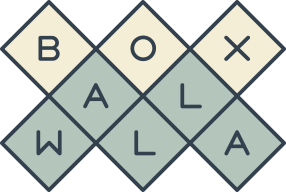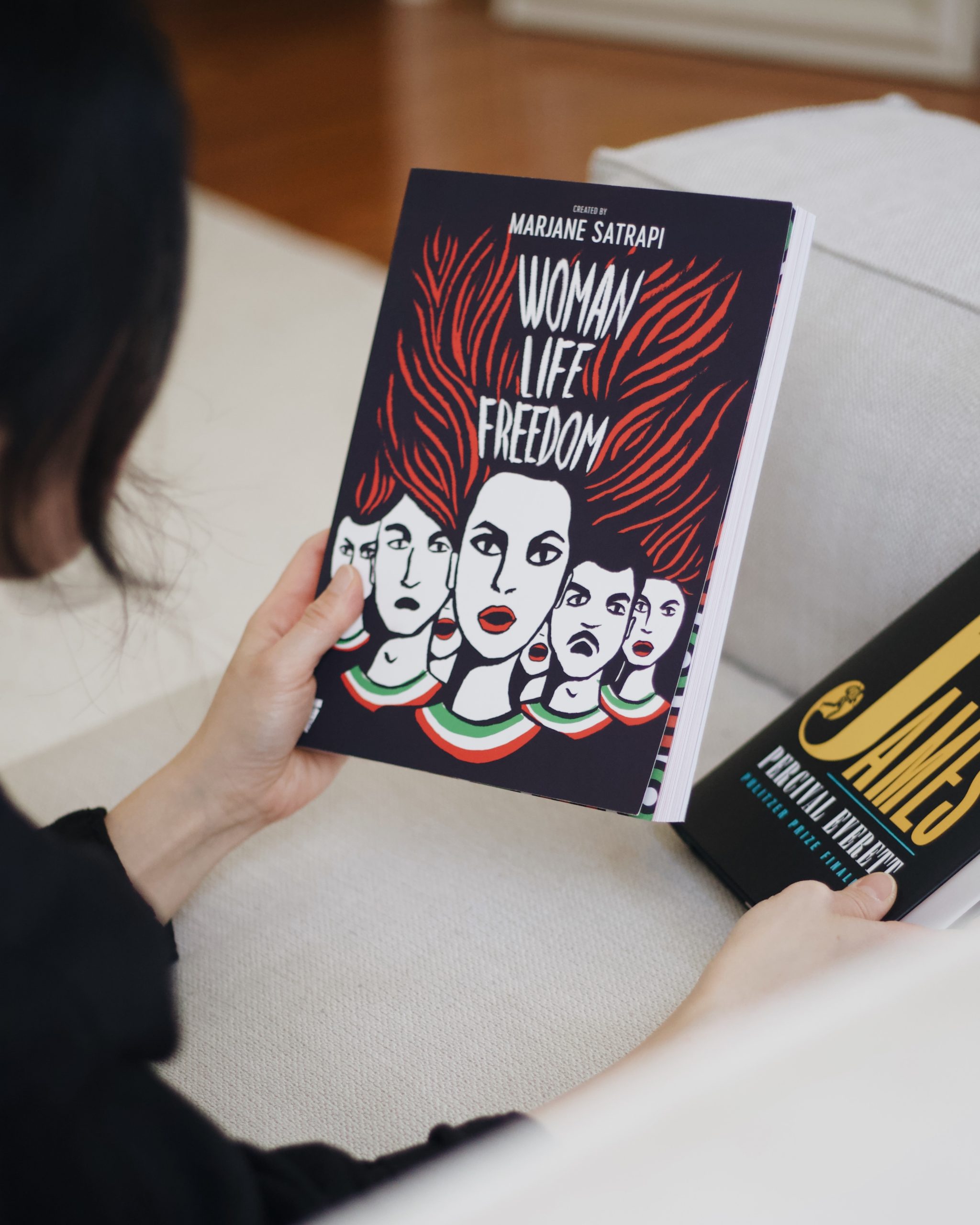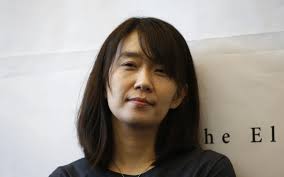When I wrote this, students protesting in UCLA were attacked by a mob, while the police did nothing for two hours. Then, their barricades were removed by the police. The news is the same on the other coast: the NYPD has been called to end the student occupation of Columbia University. The last time students of Columbia occupied the university, they did it to force the administration to divest from companies which were implicated in apartheid South Africa. Currently, over 2,000 people have been arrested in pro-Palestine protests in the US in the last two weeks. We seem to never learn the lessons of history. It is tempting to become jaded when we seem to be battling forces way bigger than us, and these days, I lose hope often. However, Woman, Life, Freedom, created by Marjane Satrapi, refuses to give up.
This collaboration by artists, writers, and researchers documents the revolution that broke out in Iran after 22-year-old Mahsa Amini was killed in police custody in 2022. Woman, Life, Freedom unflinchingly chronicles the many horrors the Iranian regime has inflicted on its population. The routine is the same: identify and arrest anyone who disobeys the labyrinthian rules of the state or the dictates of Islamic law, as laid out by the regime. Since the legislator, executive, and judiciary operate as one mission to keep their citizens in check, if the government has their eye on you, rules can be stretched to arrest and convict you no matter what. This is followed by torture, forced confessions, disappearances, deaths.
Page after page, illustration after illustration, the consequences are the same. Yet, Woman, Life, Freedom is teeming with hope, the joys of dissent, the fervor of revolution. It tells us that Iranian woman have always been strong and rebellious, the group most fiercely opposed to the Iranian regime. The book reminds us to never let this fire of revolution to die, to not forget the people of Iran, to remember those all over the world struggling for their rights, and to do our part. Revolutions only die if we forget to keep them alive. Women, Life, Freedom demands we keep our hopes alive; we have no option but to persevere and to fight.
Now, more than a year after Mahsa Amini’s death, the movement is still alive, its impacts still felt. Here, let’s take a look at some of the impacts the movement has had, and at some of the political and artistic work that has been inspired by the movement. We all need more stories of hope, and this is a reminder that movements and revolutions can change things for the better.
Woman, Life, Freedom: The Origins of a Slogan and a Movement
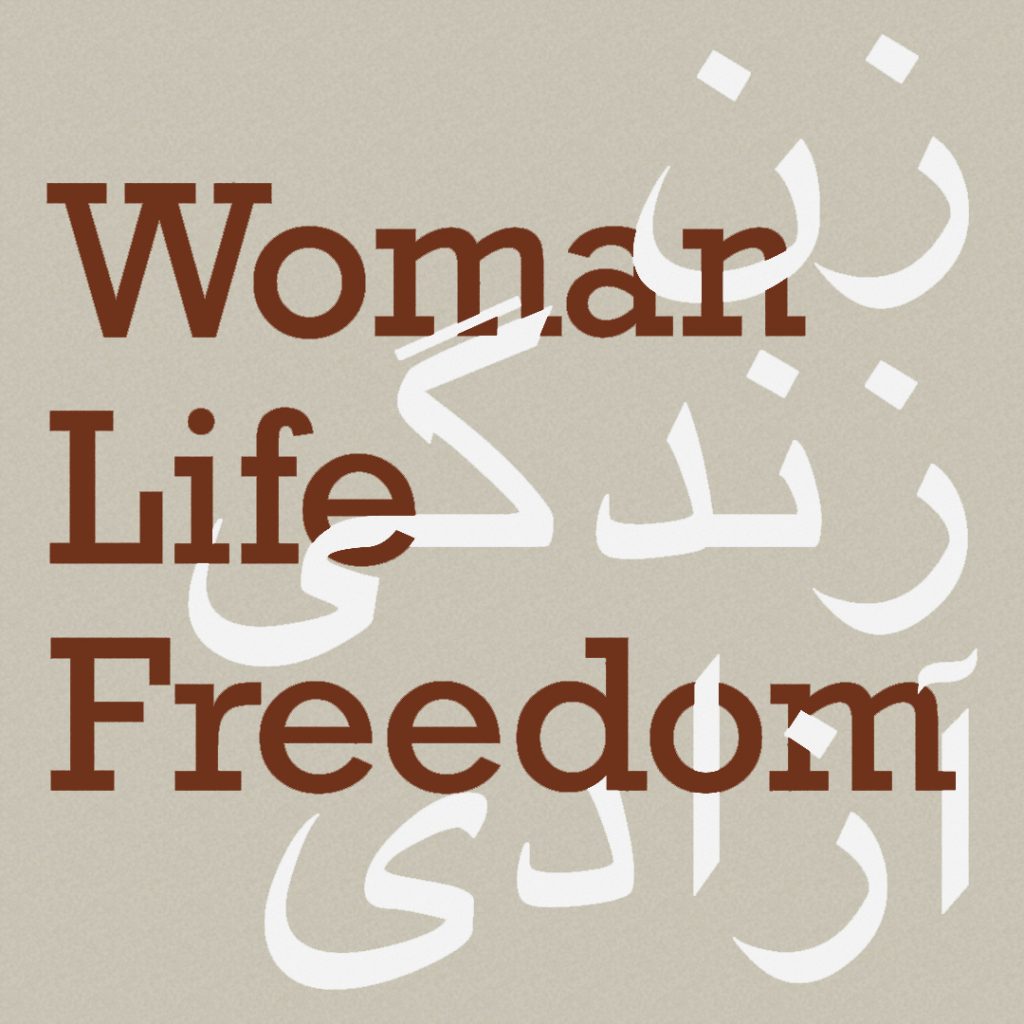
Let us first look at the origins of the slogan that has come to define the Iranian revolution. “Woman, Life, Freedom” is a Kurdish slogan, originating in 2013. Le Monde describes what is probably its first use thus:
It was likely in Ankara in April 2013 that the slogan ‘Woman, Life, Freedom’ rang out for the first time, during a meeting between the women’s branch of the BDP (Peace and Democracy Party), a predominantly Kurdish political group historically linked to the PKK (Kurdistan Workers’ Party). The founder of the PKK, Abdullah Öcalan, imprisoned in Turkey since 1999, had just called for a suspension of hostilities between the separatist guerrillas and the Erdogan government. The ceasefire’s conclusion came also with the transfer of Kurdish fighters to Syria, the famous peshmergas, who left the Bakur, the Turkish “north” of their dreamed Kurdistan, to settle in Rojava, in the west. In the same spirit, pro-independence activists call Iranian Kurdistan ‘Rohjelat’, meaning the East, and Iraqi Kurdistan ‘Bashur,’ i.e., the South. This peace process allowed the BDP to develop its activities in Turkey and to advance its feminist program, including quotas for equal representation.
In July 2014, the BDP dissolved into the HDP (Peoples’ Democratic Party), which achieved an unprecedented 13% of the vote in the June 2015 legislative elections. But the Turkish-Kurdish peace process collapsed soon afterward. It was in the ranks of Kurdish militias in Syria – linked to the PKK – that the slogan “Woman, Life, Freedom” began to resonate.
It was mainly taken up within the YPJ (Women’s Defense Units), the female component of the Peshmerga, the standing military of Kurdistan Region and an autonomous political entity within the Republic of Iraq. ‘Woman, Life, Freedom’ became the tagline of Girls of the Sun, a 2018 film that Eva Husson dedicated to Kurdish female fighters.
Mahsa Amini was a Kurdish woman from Saqqez. Her family called her by her Kurdish name Jina, meaning “life”. At her funeral, women removed their hijabs and began chanting “Jin, Jiyan, Azadî” to remind us of a long-lived Kurdish struggle against state oppression. Soon, the slogan became the rallying cry of the protests that swept Iran, and spread to all parts of the world.
“Baraye”: The Revolution’s Anthem
Two weeks after Mahsa Amini’s death, Iranian singer Shervin Hajipour shared his song “Baraye” on Instagram. It went viral immediately, with nearly 40 million plays in only two days. It has since become the anthem of the Woman, Life, Freedom movement.
In the book, Shabnam Abidan and Farida Vahid depict the impact of the song in colorful, heartbreaking, uplifting images. They also cover the context of the song. “Baraye” won the Grammy for Best Song for Social Change. Below, you can listen to the song and read the lyrics in English:
Sara Mashayekh, an English-Persian translator and PhD student, explains the deep meaning behind each verse of the song for Iranians here.
The UN’s International Fact-Finding Mission on Iran
One of the most direct impacts of the movement in Iran has had is on the the UN’s International Fact-Finding Mission on Iran (FFMI). On 24 November 2022, the FFMI was established to investigate alleged human rights violations that had occurred during the protests. The findings of the report have been damning for the regime:
The FFMI found that the Islamic Republic of Iran was responsible for egregious human rights violations under international law, including unlawful killings and murder, unnecessary and disproportionate use of force, arbitrary deprivation of liberty, torture, rape, enforced disappearances and gender persecution intersected with discrimination based on ethnicity and religion. These violations, the FFMI found, disproportionately affected women, children, and members of ethnic and religious minorities.
The full report can be read here.
The Commission on the Status of Women and Iran
An open letter from Global Women Leaders & Advocates urged UN Member States to heed the call of Iranian women and remove the Islamic Republic of Iran from the Commission on the Status of Women. It was signed by over 100,000 people; the letter can be accessed here. Solidarity to Iran was also extended through #EyesonIran for artists and activists throughout the diaspora and their allies to hold a shared vision to ensure international audiences and institutions remain awake in their eyes and hearts to this movement. The hashtag is used to spread news from Iran, even when interest in the movement has died down in mainstream media.
The UN removed Iran from the commission in December 2022.
Woman, Life, Freedom, World Press Photo
Woman, Life, Freedom was a photo-based video project that featured the work of ten anonymous Iranian photographers. Produced by Hossein Fatemi, this project narrates a chaotic night in the life of an Iranian nurse as she fights to save the life of a young man named Reza, who is badly wounded by crossfire at a protest. It was awarded the 2023 World Press Photo Contest, Asia, Open Format. You can view it here.
Arghavan Khosravi: Black Rain
Iranian artist Arghavan Khosravi combines Persian motifs with “surreal iconography, creating ghostly, enigmatic artworks that project gender, censorship, power, and cultural transience“. Black Rain was Khosravi’s first comprehensive museum survey, and featured installations directly inspired by the Woman, Life, Freedom movement. Her artwork depicts the double life she led in Iran, where her true thoughts and actions had to remain hidden. Woman are central in her work, and they are depicted as colossal warriors, in direct contrast to how the Iranian regime depicts women.
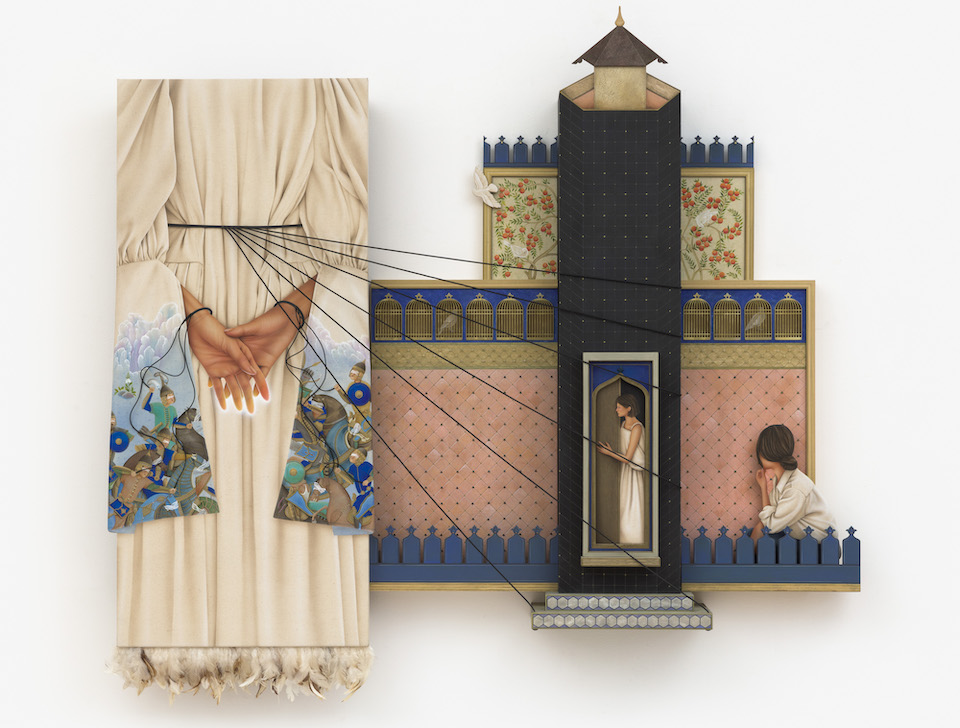
Photo Credit Arghavan Khosravi and Rachel Uffner Gallery New York
JR’s Installations
French photographer and street artist JR’s first Woman, Life, Freedom installation gathered people in Rio de Janeiro, Brazil:
In the video is 250 participants in black clothing, with their arms raised in the air. They embody the hair of 16-year-old activist Nika Shahkarami who, after being videotaped burning a headscarf during protests in Tehran, went missing. A week later, the authorities told her family she had died. This installation “showed that she and the people of Iran have not been forgotten. Their fight for women’s rights, democracy, and freedom is supported by communities thousands of miles away.” A month later, JR and his team installed Nika’s portrait at the Four Freedoms Park on Roosevelt Island in New York City.
In November 2022, placed portraits of Iranians who have disappeared after resisting the government. The video is haunting; JR’s message equally so:
“The images move with the current, representing the march of history. The people push forward together, sacrificing their lives or freedoms so that tomorrow may be better than today.”
Woman, Life, Freedom: Listening to the Movement
There is a wealth of podcasts from experts on Iran from all over the world. They shed light on what is happening in the country, and cover the Woman, Life, Freedom movement from different perspectives. If you want to know more about the movement, here are a few conversations we recommend:
- Woman, Life, Freedom: All In on Iran: a podcast series which covers various aspects of the uprising, from experts on Iran. Hosted by Nahid Siamdoust, Assistant Professor of Media and Middle East Studies at the University of Texas, each episode draws on experts’ professional insights, as well as their personal ones.
- The Crown Center for Middle Eastern Studies at Brandeis University, held a a panel discussion presented in conjunction with Khosravi’s Bllack Rain exhibition, exploring where the movement is one year later and its short-and long-term political, cultural, and economic impact. It can be accessed here.
- Iran Protests: A Feminist Social Movement: In this episode of Vis a Vis, which features conversations that challenge our understanding of key global, economic and social issues by casting them in a transatlantic perspective, Kian Tajbakhsh, a Senior Advisor at Global Centers Columbia University, talks to Emmanuel Kattan, the host, about the 2022 demonstration, and why it was different from previous such movements in Iran.
- An Iranian Uprising Led by Women: One week after Mahsa Amini was killed, the New York Times dedicated an episode of The Daily to talk about Iran. Recorded when the movement was new and underway, it is a reminder to not let the conversation die, to keep the fervor alive.
- Two weeks after Amino’s death, Al Jazeera released Woman, Life Freedom: The Chants of Iran’s Protestors on The Take. A year later, The Take looked at the movement and its effects in another episode.
- The Woman Question: An NPR episode on what was happening in Iran in October 2022.
- Women, Life, Freedom: Iran’s Movement for Women’s Rights: A range of Columbia experts explore the unrest in Iran within broader historical and geopolitical contexts, where it may lead, and how it connects with other global challenges.
- Woman, Life, Freedom: Eight months of ongoing protests in Iran: This episode features Iranian women’s rights advocate Azam Jangravi, Iranian women’s rights lawyer and writer Dr Mehrangiz Kar, and Iranian American actress, writer, and activist Nazanin Nour.
Let’s listen, read, watch, write, and breathe revolution. Let us remember oppressed people all over the world fighting at this moment and join in their struggle. Let us not allow any movement to die down. Let us scream, “Jin, Jiyan, Azadi. Woman, Life, Freedom.”
Woman, Life, Freedom was the second book in the Boxwalla April Book Box, which has sold out. You can subscribe to the Book Box here.
